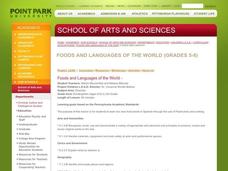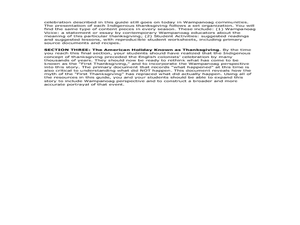Curated OER
Jim Thorpe's Bright Path
Students read about the life of Jim Thorpe and answer focus lessons about the book. In this Jim Thorpe activity, students celebrate the American Indian culture and learn of the hardships Jim Thorpe overcame. Students find descriptive...
Curated OER
Lesson One: The Three Perspectives on Native American Removal
Eleventh graders explore the impact of the Indian Removal Act. In this US History instructional activity, 11th graders analyze primary resources.
Institute for Geophysics
Understanding Maps of Earth
Here is your go-to student resource on primary geography concepts, including facts about the surface of the earth and its hemispheres, latitude and longitude, globes, types of maps, and identifying continents and oceans.
California State University
Life in the Missions of California
Academics explore the topic of life in California Missions for Native Americas. Class members complete a research activity, respond to writing prompts, and engage in hands-on-activities to learn who lived in the missions and what life...
Stanford University
Siege of Golconda
Looking at art, learners explore the Mughal Empire, which once controlled all of India and created a unique Hindu-Muslim civilization. By analyzing a painting of the Siege of Golconda, historians consider what art teaches people about...
National Endowment for the Humanities
Hopi Poetry
The Hopi refer to corn as their children, demonstrating its importance to the Native American group. Class members consider the role of literal and figurative language by examining poetry from this indigenous group. The resource includes...
National Endowment for the Humanities
Hopi Place Names
What's in a name? Historians consider the question as they examine places important to the Hopi people and the meanings of their place names. Included worksheets include maps and charts to help class members examine the geography of Hopi...
National Endowment for the Humanities
Hopi Traditional Dance and Song
Very few outsiders get to see the Hopi "Butterfly Dance." However, using approved footage from the tribe, class members consider the importance of symbols in Hopi culture by watching the dance and analyzing lyrics from its songs....
Center for History Education
Was the Stamp Act Fair?
Pledge your loyalty to the king and the Stamp Act or sign an oath against the tax. After simulating an in-class tax for school supplies, young historians consider the reasons for the Stamp Act and similar colonial policies. The...
Curated OER
Teaching With Documents Lesson Plan: Sioux Treaty of 1868
Students study the Sioux and their lives in the Black Hills before 1868. They engage in a wide variety of cross-curricular activities which give them a good understanding of the Sioux culture.
Curated OER
The Icky Sticky Indian
Students study the /i/ sound in both written and spoken words. They examine how their mouths move as they make the /i/ sound, recite a tongue twister, and write the both the upper and lower case 'i'. Next, they listen to a story while...
Curated OER
California's Mission/Rancho Era
Fourth graders complete a variety of activities as they study the Spanish colonization of California, including the relationships among missionaries and Indians and their interactions with soldiers and people in the pueblos and ranchos.
Curated OER
Map Out the Important Stuff!
Students practice summarization by creating a story map. Students listen to a read aloud by the teacher, after which the class creates a storymap of the major events in the story. They read a passage from the Indian in the Cupboard...
Center for History Education
Road to Revolution: How did Actions and Responses Lead to an Independent United States?
Using primary sources, maps, and an interactive M&M game, young historians examine the American revolution as if they were detectives trying to solve a crime. Resource includes graphic organizers and a final writing prompt to aid...
Curated OER
Indentured Servitude of Native Americans in Southern New England
Students explore slavery by researching Native American history. In this racial prejudice lesson, students identify the treatment of Native Americans in the New England area 200 years ago. Students answer study questions based on the...
Curated OER
Foods and Languages of the World
Students review Mexico's location and language and learn to pronouns 10 new Spanish food words. Students listen as the book, Corn is Maize is read, touching and passing around an ear of Indian corn. Students discuss the contribution of...
Curated OER
Native American Music: Call-and-Response
Students are introduced to call-and-response form of Native American song and dance. They identify and describe a call-and-response form as used in "0 Hal'Lwe."
Male students will perform "0 Hal'Lwe" in call-and-response style with drum...
Curated OER
Spring: Giving Thanks to the Herring
Students study the Wampanoag tribe to learn about the importance of the herring to their culture. In this Wampanoag lesson, students read information and complete multiple activities to learn about the role of the herring fish in the...
Curated OER
A History of Conflict
Students explore issues contributing to the current conflict over the Kashmir region; Indian and Pakistani leadership and steps towards peace since the Indian subcontinentgained independence from British rule in 1947.
Curated OER
Lesson 3
Students demonstrate knowledge of geography and early inhabitants of Virginia by locating and identifying water features important to early history. They also locate three American Indian language groups. Both of these activities require...
Curated OER
What Comes From Corn
Students name and examine various items that are made from corn. Students compare ears of corn to Indian corn, and cook several items made from corn. Students create a popcorn picture and illustrate a book.
Curated OER
Aboriginal Physical Education
Learners engage in p.e. activities that have roots in native Indian, Metis, and Inuit cultures. They practice the skill involved and listen to the significance behind the skill. They read relevant books and define new terminology.
Curated OER
Native Americans - People of the Plains
Students explore Plains Indians and practice computer skills by reading creation and migration stories on People of the Plains CD-ROM, and watching Plains video. Students examine village life of Plains Indians, and view different...
Montana Office of Public Instruction
Native American Culture: Counting, 1:1 Correspondence
Kindergarteners practice showing 1:1 correspondence while incorporating information they learned about a local Native American culture. The objects used for counting are taken from the previous day's Native American lesson. The intention...
Other popular searches
- French and Indian War
- American Indians
- Indian in the Cupboard
- French Indian War Lesson
- French Indian War
- Sioux Indians
- +French +Indian +War
- Indian Removal Act
- Iroquois Indians
- Cherokee Indians
- Eastern Woodland Indians
- Indian Reservation

























